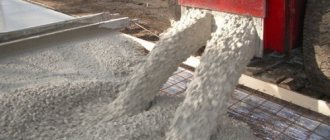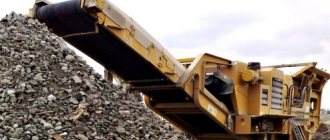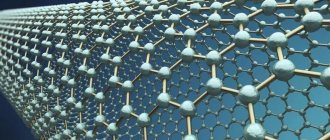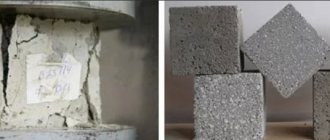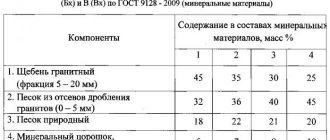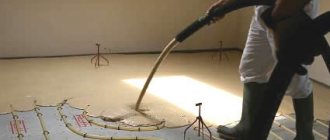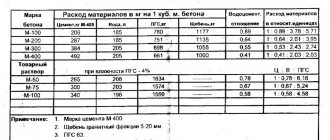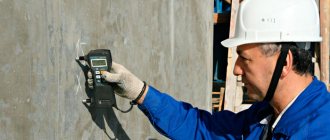A new solution in the field of architectural concrete production is Kevlar concrete technology. This material has a glossy surface that imitates the coating of artificial or natural stones or a marble pattern. It is produced by gravity mixing in a special concrete mixer. The product has a rigid frame made of grains with fractions up to 5 mm, which provide additional strength, prevent cracking and help eliminate air bubbles from the mixture.
Kevlar concrete is also called ultraconcrete, granite or pelletized concrete.
Composition of building materials
The set of initial components and forms between heavy concrete with marble chips and Kevlar concrete is the same. The difference lies in the preparatory stage before pouring into molds. During the production process, concrete pellets are obtained, which adhere to granite screenings. These are balls, inside of which grains of sand, different fractions of screenings and Portland cement are tightly interlocked with a core in the middle. After the pellets are unloaded into plastic molds, under the action of a resonator, all microparticles flow into a single mixture - a monolith of the desired type. And large particles of Kevlar concrete merge into a rigid lattice skeleton, which affects the properties of concrete, increasing its resistance to fracture and compression. The pellet consists of the following elements:
- screening grain with dimensions up to 5 mm (kernel);
- small inclusions of grains;
- dense conglomerate - sand, cement, various small microparticles up to 3 mm.
During production, you must first obtain special pellets.
As with any concrete test, Kevlar concrete contains:
- mineral coarse filler with clay inclusions up to 3%;
- granite screenings of various fractions, crushed stone or screenings of dolomite, basalt;
- fine sand;
- Portland cement grade not lower than M400 and without additives;
- plasticizer to accelerate the hardening of pellets (S-3 or SP-1);
- pigments for coloring;
- mixing water (mass fraction of water 17%).
Overview of the characteristics and properties of Kevlar concrete
This type of material is much more frost-resistant than all other mixtures.
Kevlar has a strength grade of at least M600 (class B45), which means that the material is capable of withstanding a compressive load of 600 kgf/cm2. The frost resistance class of Kevlar concrete is F700, where the numerical value is cycles of alternating freezing and thawing without reducing its tensile strength by more than 5%. For comparison, most simple concretes have a frost resistance of F50-F150.
The surface of Kevlar is glossy and smooth to the touch, its secret lies in the water-cement ratio of the materials. Water saturation of kevral concrete is 0.5% with a possible acceptable level of 5%. When exposed to water and snow, the building material has almost zero slip. Light-resistant iron oxide pigments paint the product in any desired color and their consumption is at least 2 times less than when painting conventional grades of concrete. With the help of such paints, the entire solution is not completely painted over, creating stains simulating natural stone.
Compared to conventional concrete products produced using the vibration casting process, products made from pelletized concrete are better in quality, with high decorative properties and physical and chemical properties.
Product manufacturing
The production of Kevlar concrete products is a profitable and promising business. Finished products have a wide variety of colors, imitating various artificial and natural materials.
They are aesthetically attractive; it is possible to produce products whose elements will glow in the dark. They have the following characteristics:
- Compressive strength class – B 40 and above
- water resistance – W 15 and higher
- frost resistance – F 700
- abrasion – 0.2 g/sq.cm.
- water absorption – 0.5%.
Technology for the production of building materials using the gravity clumping method
When making such material, you need to use a vibrating table.
You can make concrete with Kevlar with your own hands, knowing the technology and tools. In addition to producing concrete for your own needs, it is quite possible to start producing kevral concrete as a business. The main equipment is a concrete mixer and a vibrating machine. Sewerage and drainage are not needed. The investment will pay off within a month of production. To do this you will need the following equipment:
- gravity type concrete mixer;
- mixture components;
- scales;
- shovel;
- vibrating table;
- polyethylene film;
- forms.
The production technology of Kevlar concrete is carried out according to the following scheme:
When the pigment is added to the composition, you can fill the form with it.
- Kneading the mixture. Dry components are poured and mixed in a concrete mixer for no more than 1 minute.
- Adding cement. Add Portland cement and knead for another 1 minute.
- Compliance with proportions, adding plasticizer. In cement paste, the movement of parts is slow in some places, so a plasticizer is added to ensure uniform mixing. It is diluted in hot water, stirring constantly so that it does not crystallize.
- Inspection of pellets. Beads are selectively selected and broken to assess their internal composition. The conclusion about the readiness of the mixture is made by the diameter and density of the pellet body.
- Input of pigments. Once the final shape of the pellets is accepted, paint is added, which is applied only to the top layer of Kevlar, thereby reducing the consumption of pigments. The paint is added dry and in small parts and mixed for no more than 10 seconds.
- Loading raw materials into plastic forms. When the molds are filled to 80%, the vibrating tables are turned on, after which they add more until the mold is completely filled and covered with thick plastic film. Drying occurs within 24 hours. After stripping, the products must rest for 5 days.
Business plan for a concrete plant, profitability of concrete production
The concrete production business is considered one of the most profitable, since the demand for it is always high, especially from the construction sector.
Therefore, it is recommended to open a mini-factory at the beginning of the construction season - in May. Then by the end of it, in November, you will be able to promote production and get a good income. First of all, a business plan for a concrete plant must evaluate the competition and develop a pricing policy for doing business. The main buyer of the product is the construction business, which consumes 94% of all concrete offered on the market. The difference coefficient between the growth rates of construction and concrete production is 0.9.
At the same time, the production of concrete mixtures has a limited geographical focus. On average, it is profitable to transport them over a distance of about 50 km. Therefore, first of all, you need to assess the level of competition in your region.
As practice shows, it will not be possible to win the competition by lowering prices for materials. Moreover, factories produce approximately the same brands of concrete mixtures with the same characteristics - the technology for their production is simple and accessible to everyone.
The level of sales will depend on how active construction is in your region.
The sale of other building mixtures that can replace concrete and various reinforced concrete prefabricated products may provide significant competition to you. The only thing that will help you withstand competition is long-term relationships with consumers.
Formalities of the case
The business plan for a concrete plant must first of all provide for the registration of the enterprise as an LLC. Firstly, if the enterprise is unsuccessful, you will only lose the authorized capital.
Secondly, any enterprise will cooperate with a legal entity. Taxation can take place according to a simplified or general system. The first is chosen if it is planned that the enterprise’s profit will be over 60 million rubles.
But in this case, it will be necessary to completely maintain all accounting records.
For this activity, choose the OKVED code: 26.63 - “Production of ready-mixed concrete.” Manufacturing technology must comply with the following standards:
- GOST 18105 – 86 – “Concrete – rules for strength control”.
- GOST 10181-2000 – “Concrete mixtures – test methods”;
- GOST 10060.0-95 – “Methods for determining frost resistance”;
- GOST 27006-86 – “Concrete. Rules for selecting the composition";
- GOST 26633-91 – “Heavy and fine-grained concrete. THAT";
Business Features
The sale of concrete mixtures is characterized by a significant problem - transportation of goods to sites. It must be quickly finished and loaded before it hardens, and yet has a low cost per unit weight. It is delivered to the site in special concrete mixing vehicles. Or concrete forms are prepared, which harden at the factory and then delivered to the site.
It is advisable to produce it directly at the construction site. That is why the market for the product is extremely limited.
The technology for preparing concrete mixtures in the classic version will require the use of the following components:
- The water is clean, without impurities. The amount is determined based on the moisture content of other components.
- Ballast is the so-called general mixture, sand and gravel. The optimal proportions are one part river sand to three parts gravel.
- Crushed stone - this can be crushed gravel, preferably rocks with a diameter of over 5 mm. You can use slags.
- Sand corresponding to GOST 8736-93, no more than 0.5 mm in diameter of sand grains.
- Cement is the basis of the mixture, a binder. Gray powder that crystallizes and hardens when moistened.
Despite the fact that the technology for producing building mixtures is simple, special production lines are usually installed that are fully automated. They allow you to strictly adhere to the established recipe. This line includes the following units (cost - thousand rubles):
- The cabin where the control panel is located (100).
- Dispensers separately for water and separately for cement (150).
- Plate conveyor (50).
- Rail loader (80).
- Return exit conveyor (95).
- Lift (50).
- Reducer (100).
- Belt conveyor with a capacity of 50 m3/hour (90).
- Basic concrete aggregate dispenser (320).
- Dispenser for ready-mixed concrete aggregates (260).
- Auger (135).
- Basic concrete mixer (46.5).
- Facial concrete mixer (43.3).
- Silo for 60 tons 40 m3 (477.9).
About 2 million rubles will have to be allocated for the purchase of equipment.
Brief business plan
The manufacturing technology of this building material involves zoning production areas into the following parts:
- Auxiliary premises.
- Administrative and household.
- Raw materials warehouse.
- Boiler room.
- Cement warehouse.
Most premises need to be built and renovated. The costs of this work will amount to about 280 million rubles.
The most popular brands of cement, with which it is recommended to start your business, are: heavy concrete grade M 250 and grade M 350. The annual volume of the first should be at least 360 thousand m3, the second - 640 thousand m3.
Raw material costs
This type of cost is calculated from how many components per unit of production a specific production technology requires, or what the production volume will be per year.
The technology for manufacturing concrete grade M 250 will require the following number of components per year:
- sand – 16.5 thousand m3.
- crushed stone – 28.8 thousand m3;
- cement – 13.86 million tons;
Brand M-350:
- sand – 28.8 thousand m3.
- crushed stone – 48 thousand m3;
- cement – 26.88 million tons;
We invite you to read: Planting potatoes under straw: methods and technology of growing under hay
In total, about 553,770,000 rubles will be needed per year to purchase the raw materials of these two brands.
Other costs
A small production must be served by 49 people. Salary rates for the year will look like this:
- 4 drivers – 960,000 rubles;
- 10 workers of a block of support services – 2,400,000 rubles;
- 9 aggregate warehouse workers – RUB 3,240,000;
- 12 cement warehouse workers – 4,320,000 rubles;
- 9 workers of the concrete mixing shop - 4,320,000 rubles;
- 5 people of administrative and management personnel – 4,800,000 rubles.
RUB 20,040,000 should be allocated to pay for their labor. in year. In addition, it is necessary to take into account the costs of using equipment, shop and general plant costs - a total of about 2,385,836,500 rubles. in a year.
Profit margins
From the sale of concrete grade M 250, you can earn 1,404,000,000 rubles per year. Sales of the M 350 brand will bring another 2,624,000,000 rubles. Without taking into account VAT, you can receive 3,302,960,000 rubles for the year, and taking into account all deductions - 917,123,500 rubles.
According to experts, the profitability of such an enterprise reaches 38%. Investments can pay off in just four months.
To increase efficiency and simplify maintenance, concrete production plants are equipped with automation systems. This helps reduce human involvement and reduces the number of possible errors. A small plant, with a normal operating cycle, can produce 30-60 cubic meters of mixtures per hour.
The cost of equipment sets may vary significantly. The final price of the plant depends on the type, performance and additional devices chosen by the buyer. The most affordable option can be purchased for 1.5 million rubles. For a fully automated plant with high productivity, the company needs to pay about 8-12 million rubles.
Mobile equipment for the production of concrete mixtures, in contrast to completely stationary ones, can, if necessary, be dismantled in a very short time, loaded onto platforms, transferred to a new facility and put into operation there. In this way, the entrepreneur can provide the construction site with the necessary materials right on site. Before choosing a set of equipment, you need to consider the scope of its application and the required volumes.
Automated lines do not require a large number of workers, eliminate errors and are an excellent investment for the future. The experience of implementing such plants shows that businessmen can earn up to 1 million rubles or more monthly from them. To maintain production, it is enough to maintain a staff of three workers.
Specialists involved in the production of concrete in automated plants do not need special knowledge or lengthy training. Employers benefit from this option because they can significantly reduce costs.
Ready-made mixtures prepared by a stationary plant must be delivered to the customer on time. The load is specific and in order to avoid delamination of the concrete mixture, it requires fast delivery, so you need to purchase suitable equipment. If you choose a domestic concrete mixer truck based on a KAMAZ loading platform, you will have to spend an amount of 2.8 million rubles. Imported mixers are much more expensive.
The operating principle of all concrete plants is essentially the same. To better understand the processes occurring inside a concrete plant, which are hidden from the eye of the observer, watch this short video. Thanks to animation, the walls will become transparent and the processes clear.
Application area of Kevlar concrete with smooth surface
The main application is cladding and finishing. Pelletized concrete is used for the manufacture of the following elements, objects and structures:
- tiles for laying sidewalks;
- fences and hedge elements;
- curbs along paths;
- fireplaces;
- flower beds;
- facade stone;
- elements of landscape architecture;
- steps.
You can make beautiful steps from this material.
The material is suitable for the manufacture of facade stone.
The characteristics of Kevlar concrete in terms of frost resistance, abrasion and moisture resistance, resistance to chloride penetration and gas resistance make it in demand and popular in the design of facades, playgrounds for children, architectural and decorative elements of buildings and structures. The most important advantage of this technology is the use of common, inexpensive components.
